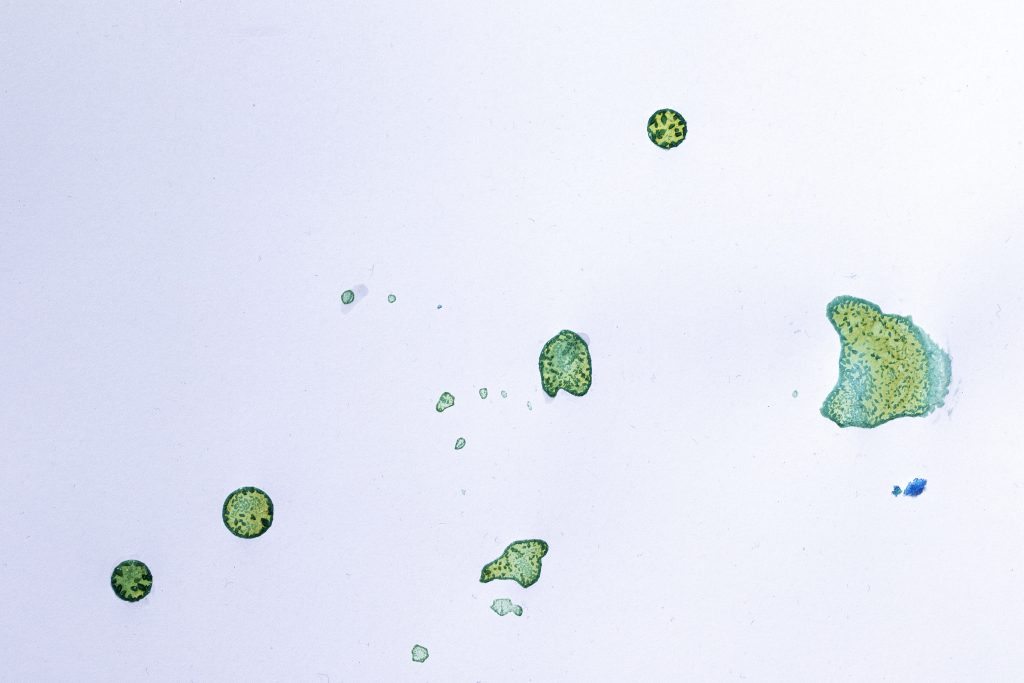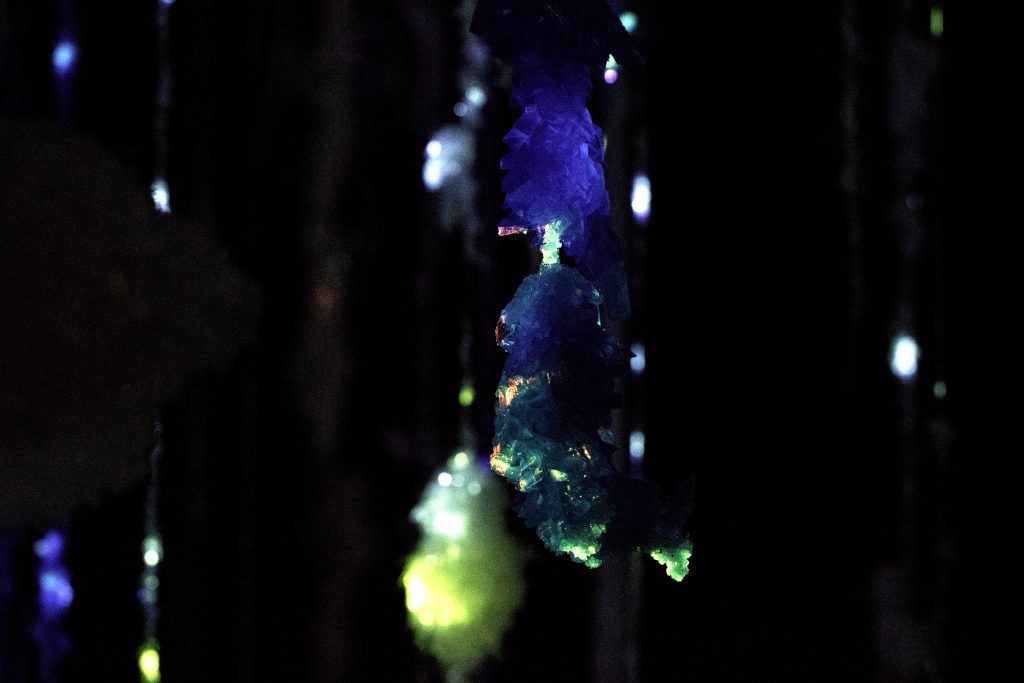Saltworks
Elaine Ford
INTRODUCTION
Captivated by the complex biological and physical phenomenon of the natural world and our perception of time and space, I experiment with data visualisations to inform and create new layers of interpretation by growing salt crystals to draw in space. The saltwork reflects the fragility and changing chemistry of our ocean ecosystems. Using puffin movement and ocean data, I explore impermanence and the interconnections of our living planet. Drawn to the fragile, light-reflecting qualities of the crystals, the saltwork captures moments of puffin flight, swimming and diving. The puffin movements, relating to the depth of the sea, are transformed through salt crystallisation as an artmaking process, seemingly encapsulating the forces of nature.
Multiple experiments revealed the dominance of repeating patterns in the salt crystal formations and also the bathymetric data, which highlights the self-similarity of nature.The crystal structures are analogous to topography: the building of matter, minerals, layers of sediment over time denote notions of memory, time and transformation. I project puffin movement as light on saltworks, illuminating their intricate complex shape and texture. As with the changing nature of the ocean, these structures are temporary, dissolving, evaporating: reinforcing ephemerality.

DATA
Fascinated by the power of satellite technology to enable the conservation of wildlife and natural habitat, and the realisation that birds can act as environmental sensors, I partnered with Royal Society for Protection of Birds (RSPB) who had obtained bird movement data from Project Puffin in the north of Scotland. Small tags record the movement of puffins as they fly vast distances, feed, swim, and dive as deep as 200ft. The GPS data is taken at regular intervals over land and sea during their breeding season.
The data revealed that puffins spend most of their lives at sea. Exploring visuals of the sea, I found that most images are of the sea surface, experiencing its skin, and I was intrigued by the elusive experience of the ocean beneath. To reveal unseen morphology and explore satellite data to sense the ocean, I harnessed bathymetric data and Sentinel-2 Earth Observation data with the movement of puffins. Interestingly, I found puffins were very active during both day and night. Collaborating with Space Intelligence, I created a digital tapestry based on the GPS signal of one puffin, from Fair Isle, Scotland over 1 day with white and blue crystals corresponding to day and night. The length of the crystal relates to the depth of the ocean at that space and time.



Visualisation of the movement of puffins recorded from space, enabled by GPS tags placed by RSPB Project Puffin.
Data collected from 4 colonies in northern Scotland:
- Fair Isle
- Hermaness
- Shiants
- Foula.

THE CREATIVE PROCESS
Drawing from writings, poems, academic papers, journaling and sketching, I investigated ways to interpret GPS data. Realising puffins’ connection with – and awareness of – their environment, I studied the interconnections between life and the ocean. I became fascinated with the sensuous aspects of the ocean, what we as humans can’t sense that other animals can. Enchanted by the mysteries behind the movement of puffins and their ability to navigate vast distances and return back to their exact birthpalce after years of being in the open seas, I explored the idea of mental maps: water having memory, layers, communication and vibration of the sea floor.
Drawing from the sea both figuratively and literally, I experiment with growing salt crystals to reflect the fragility of our ocean ecosystems. Puffins are a red-listed species, with climate change as a major threat. The saltworks explore aspects of climate regulation, perception of time and changing states. I build structures to experiment with substrate surfaces and high salinity baths. Using different salts, water, varying solution, temperature and light, I explore new textures, structure and growth of crystals. I manipulate the salt to create pathways for crystal growth to map the patterns of the natural world. I use salt to draw on paper, canvas and in space. Birds can capture light like no other animal, I explore puffin movement during day and night as light, illuminating the saltwork.
Image Left: Drawing crystals. 2020. Salt, copper sulphate, water, paper, varnish.
COLLABORATION
This artwork was created in partnership with Royal Society Protection of Birds using Global Positioning System data that is part-funded by National Lottery Heritage Fund. Project Puffin expertise in understanding puffin behaviour and habitat modelling is instrumental to the creative process. RSPB Conservation Scinetist, Connie Tremlett kindly presented Puffin Project and Puffazzi citizen science project in the artwork in progress talk.
Data visualisations were instrumental to the development of the work, as were artistic and technical support from Ray Interactive and Space Intelligence.

Elaine is a visual artist working in mixed media, glass sculpture, installation and painting. With a BSc in Biology with Ecology, integrating MSc Tropical Biodiversity, and a BA in Fine Art with Digital Crafting in Glass from Edinburgh College of Art, Elaine explores the interplay between science, technological innovation, biodiversity conservation and adventure. Her work focuses on the creation of immersive experiences to engage with remote landscapes and wild animals. In collaboration with Wild Immersion, she has exhibited immersive content in Paris, Los Angeles, at Burning Man and at home in Edinburgh. Elaine is currently developing a long-term project exploring the application of 360 film-making techniques in the Okavango Delta, to help diverse communities around the world experience wildlife up-close and engage with the latest conservation issues.
CREDITS
Design Informatics Team
With thanks to Royal Society for Protection of Birds (RSPB) Project Puffin: https://www.rspb.org.uk/reserves-and-events/events-dates-and-inspiration/puffarazzi/
Space Intelligence: https://www.space-intelligence.com/
Ray Interactive: http://www.rayinteractive.org/
European Space Agency
General Bathymetric Chart of the Oceans (GEBCO)

















